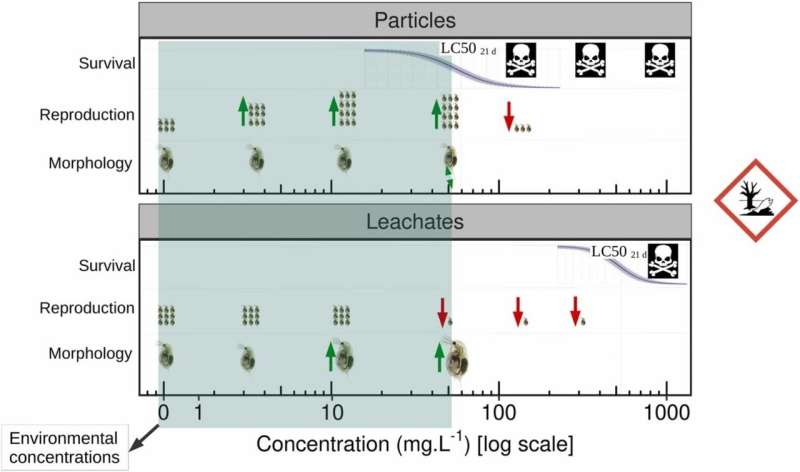This article has been reviewed according to Science X's editorial process and policies. Editors have highlighted the following attributes while ensuring the content's credibility:
fact-checked
peer-reviewed publication
trusted source
proofread
Microparticles from road tires are 'high concern' pollutants, research shows

Plastic microparticles released into the environment from common road tires should be treated as a "high concern" pollutant that may exceed chronic safety limits in some heavily contaminated environments, new research has shown.
A team of researchers, including experts from the University of Plymouth and the University of Exeter, looked at the chronic toxicity of particles and chemical leachates found on a series of popular tire brands. They then looked at the effect these particles and chemicals would have on small planktonic crustaceans, water fleas (Daphnia magna).
They discovered that the plastic pollutants from the tires showed a distinct effect on both the reproduction and development of the water flea—which also displayed visible particle uptake within its digestive tract.
When looking at the leachates—liquid that has passed through the tire material, taking some of the harmful chemicals with it—the researchers found a strong presence of zinc, titanium and strontium as well as many organic chemicals. Overall, of the numerous organic chemicals present during the test, more than 50 were found across all five tire brands, with a significant number of those chemicals classified as very toxic.
This new research shows that tire particles are hazardous pollutants, and should be treated as a particular concern, close to or possibly above chronic environmental safety limits in some locations, researchers say.
The research, published in the Journal of Hazardous Materials, is part of the "TIRE-LOSS: Lost at Sea—where are all the tire particles?" project being led by the University of Plymouth.
Professor Richard Thompson OBE FRS, Head of the International Marine Litter Research Unit at the University of Plymouth, leads the TIRE-LOSS project and is a co-author on the new study.
"Our previous work has shown that road debris is a major source of microplastics in the environment. In recent years, we have been working with partners across research and industry to determine how those particles distribute and their potential to cause harm," says Prof. Thompson. "This new study is of key importance because it demonstrates the potential for harmful effects on an aquatic invertebrate species, at concentrations similar to those we have recorded near to roads in the U.K. It is clearly an area we need to explore further."
"Tires exert a complex toxic pressure to wildlife because they release plenty of toxic chemicals as well as tiny particles that can be ingested, so both chemical and physical effects are occurring," says Dr. Paul Boisseaux, lead author of the study.
The use of tires by cars, buses and other vehicles is a ubiquitous feature of modern life, all served by a mass global tire industry that is forecast to grow about 3% each year.
Tire-tread particles generated during roadway use are a major environmental pollutant, with a significant proportion being washed away into waterways near traffic networks. It is estimated at about 18% of these particles eventually reach freshwater, while 2% reach estuaries.
However, while previous research suggested there may be concentrations of these particles in the environment, the toxicological effects they have on aquatic organisms were less well understood.
For this study, the team used several popular tire brands from around the world to generate a tire tread microparticle mixture. The toxicities of both particles and chemical leachates were then studied on the test species, the water flea. They found that over a three-week period, pristine tire tread microparticles were more toxic (concentration being lethal for 50% of the population, LC50, is 60 mg.L‑1) than chemical leachates alone (LC50 542 mg.L‑1).
The results suggest the particles were more toxic to water flea than the more commonly studied polyethylene microplastics.
More information: Paul Boisseaux et al, Deep dive into the chronic toxicity of tyre particle mixtures and their leachates, Journal of Hazardous Materials (2024). DOI: 10.1016/j.jhazmat.2024.133580
Journal information: Journal of Hazardous Materials
Provided by University of Plymouth





















